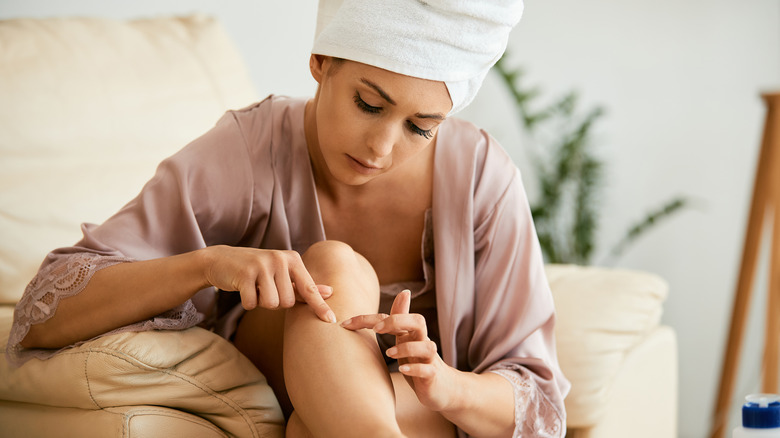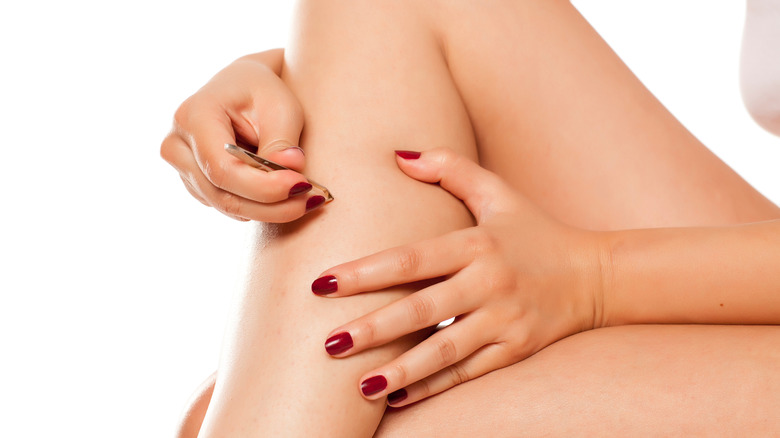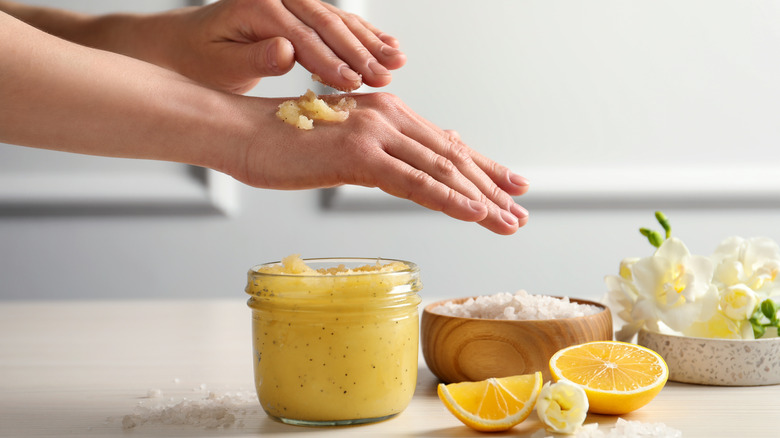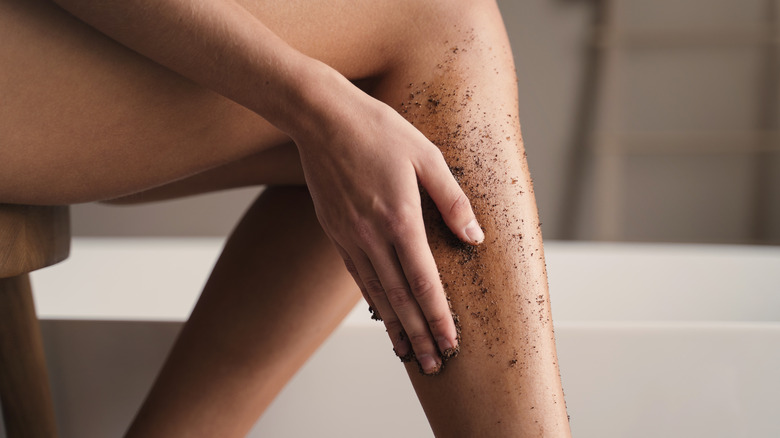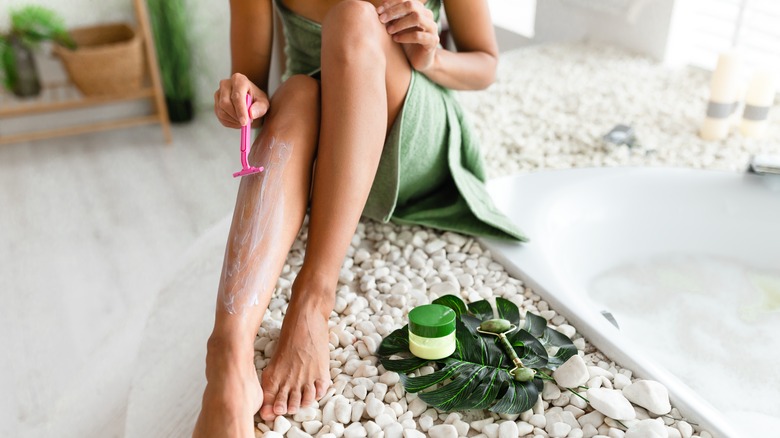Wait, Can Ingrown Hairs Leave Scars? Yep & Here's How To Get Rid Of Them
Ingrown hairs are simply the hairs on our body that grow into our skin, hence the name "ingrown." (Yes, they got super creative with the name). These hairs will form a little bump or bubble on your skin, and these bumps are sometimes filled with pus, leading to swelling, and can even cause irritations.
Ingrown hairs aren't anything uncommon or new. For those of us who shave, wax, and pluck our body hair, ingrown hairs and the stubborn little bumps they come with are the familiar but unwelcome guests we have to put up with. And those of us with thick, curly hair fall victim to the evils of ingrown hair more often than our friends with thinner hair.
But these small bumps aren't even the worst part. The scarring, discolorations, and hyperpigmentation they cause are the real pain. And that is what we are going to help you get rid of. When it comes to bumpy, spotty skin, we've got you covered.
Practice self-discipline to prevent scars
As tempting as popping that pimple might be and no matter how desperately that itch needs scratching, you are not allowed to touch your ingrown hair bumps. So, hands off. We know it's easier said than done, but touching those bumps and trying your best to pop them is only going to cause more damage. Attempting to dig out the hairs from under your skin can lead to bacterial infections. And an infection can lead to a host of other issues like inflammation, hyperpigmentation, and even deeper scars.
The first step to avoiding scars caused by ingrown hairs is to restrain yourself from performing pseudo-surgery on those little bumps. Let your ingrown hairs heal on their own. To speed up the healing process, place a warm compress on the affected area to allow the hairs to come to the surface. The heat will allow your pores to open up and create an exit for the hair. Keeping your hands to yourself can go a long way when it comes to soothing and preventing scars, so do your best and consider it a lesson in self-discipline.
Make a trip to your kitchen
Your kitchen pantry can often provide the same results as the fancy concoctions you buy and a trip to your kitchen may offer you the right remedy for your scars.
When life gives you lemons, use them as bleach. Your scars stimulate an increase in pigmentation, which causes dark spots. To get rid of these spots and brighten up any discoloration, you can use lemon juice, which is a natural, gentle bleach rich in vitamin C. Dip a Q-tip in lemon juice and apply it on your scars; leave it on for a few minutes and rinse away with warm water.
Also, green tea is a major green flag when it comes to skincare. So, the next time you are sipping on a cup, don't throw away the tea bag. Squeeze out the excess water and place the warm tea bag on your scars. Green tea is known for its plentiful antioxidants and anti-inflammatory properties, so it will help in soothing your skin. It might also potentially help heal those scars. Positive effects have been seen in some studies per a review published in the Archives of Dermatological Research.
Try these creams and gels
Your local drugstore is filled with creams and gels that can help get rid of scars the easy and fast way; you just need to know what ingredients to look for.
Glycolic acid is something you should be on the lookout for in the ingredient list. This lightweight acid aids in getting rid of oil and dead skin cells that obstruct hairs from growing out of the skin barrier. It is also useful when it comes to solving hyperpigmentation, so battling your scars with glycolic acid is a good idea.
Also, raid your vanity and look for creams with retinoids (a synthetic form of vitamin A). Your findings are probably all anti-aging creams; however, the good news is you can use retinoids for scars as well.
While there isn't much data showing that aloe vera gels can help scars, people have reported that they helped them. Onion extract gels are also helpful when it comes to soothing inflammations and sorting out your scars. This is due to their anti-inflammatory and antioxidant properties. And they can even be used on keloid scars.
Scrub it all away
Exfoliating goes a long way when it comes to preventing ingrown hairs. Ingrown hairs are caused by dirt, dead skin cells, and oils that obstruct your body hairs from growing out. A good way to put an end to all of the dirt and oil deposits is exfoliation.
So, grab your body scrub, body brush, or loofah scrub and jump in the shower and do away with all of your dead skin cells. For a more effective exfoliation session, you can use salicylic acid. It will not only penetrate deep into your pores to get rid of all the dirt build-up, but it will also help in keeping away bacterial infections.
Scrubbing is a lot of muscle work, but here's the good news: You don't have to do it every day. In fact, doing it every day is considered counterproductive; so make sure you are only exfoliating 1-2 times a week.
Fix up your shaving routine
Following the right method when shaving is key when it comes to avoiding ingrown hairs and preventing scarring. For a shave that'll save you the scars and the ingrown hairs, follow these steps:
- Start by washing your skin using a gentle cleanser and then exfoliate to get rid of dead skin cells and dirt. By doing so, you are preparing a clean surface for an easy and effective shave.
- Make sure your skin is warm and wet to prevent your hair from curling up; leaving the shaving for the end of the shower works best.
- Then rub on your shaving cream and remember to be generous with it; it helps if it's the moisturizing kind. Leave it on for a few minutes for your skin to absorb the moisture. Make sure to reapply if it has gone dry.
- The main event, or the actual shaving itself, should be done with precision; and, for that, you need a sharp blade. Not only should the blade be sharp, but it should also be squeaky clean, so use disinfectant to clean it before use. Shave in the direction of your hair growth and use pressure evenly. Clean your razor in between each stroke to ensure consistency. It's going to take a while, but doing it right will ensure ingrown hair-free skin, so take your time.
- Finally, to cool down and tighten the skin, apply a moisturizer or a cooling gel.
Use these professional methods
If over-the-counter medications or home remedies aren't working out for you and if you're still stuck with those stubborn scars, book yourself an appointment with a dermatologist. They will most likely recommend getting laser treatment or a chemical peel to remove the scars. The treatment option that's best for you will depend on your skin type and the nature of your scars.
In the laser treatment option, your scar tissue will be removed, and your skin will be resurfaced. Don't let the name throw you off; it's a safe procedure, and it works wonders on scars that have been sticking around for the longest time.
In a chemical peel, the chemicals applied onto your skin will peel away the layers of your skin in the days following your treatment, which will remove the layers of damaged skin, blurring away the scars.
For silky smooth, bump-free, even-toned skin all over, make sure you're not picking on those ingrown hairs and you are exfoliating, practicing proper skincare, and following the right shaving routine.
